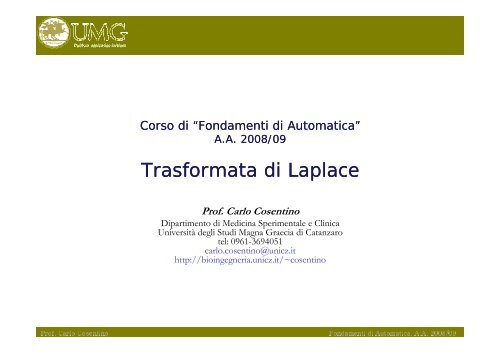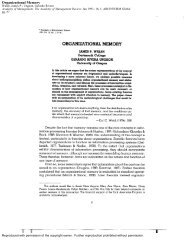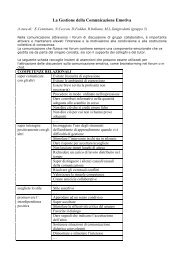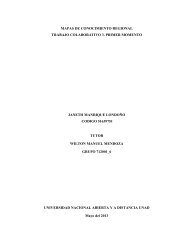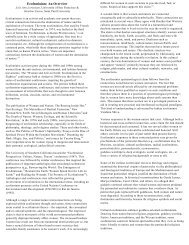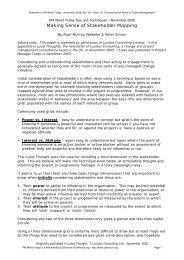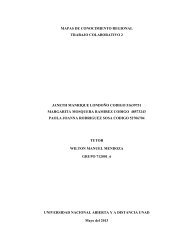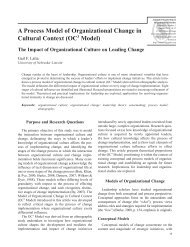Trasformata di Laplace Trasformata di Laplace Trasformata di Laplace
Trasformata di Laplace Trasformata di Laplace Trasformata di Laplace
Trasformata di Laplace Trasformata di Laplace Trasformata di Laplace
- No tags were found...
You also want an ePaper? Increase the reach of your titles
YUMPU automatically turns print PDFs into web optimized ePapers that Google loves.
Concetti Principali Definizione Trasformate fondamentali Principali proprietàProf. Carlo Cosentino Fondamenti <strong>di</strong> Automatica, A.A. 2008/092
<strong>Trasformata</strong>: Definizione La trasformata <strong>di</strong> <strong>Laplace</strong> <strong>di</strong> una funzione f(t) si definisce come−stf () t → F() s = L( f()) t = ∫ f()t e dt0 Si noti che t è una variabile reale, mentre s è una variabile complessa.+∞Prof. Carlo Cosentino Fondamenti <strong>di</strong> Automatica, A.A. 2008/093
Antitrasformata: Definizione Viceversa, data la F(s), è possibile ottenere la funzione originaria f(t)me<strong>di</strong>ante anti-trasformazioneF12πjσ + j∞() s → f ( t)= ∫ F()sσ − j∞e st dsProf. Carlo Cosentino Fondamenti <strong>di</strong> Automatica, A.A. 2008/094
Funzioni <strong>di</strong> Interesse Le funzioni <strong>di</strong> interesse per le applicazioni nel settore dell’automatica (<strong>di</strong> cuici interessa calcolare la trasformata <strong>di</strong> <strong>Laplace</strong>) sono Il gra<strong>di</strong>no 1(t) La rampa t⋅1(t) L’impulso δ(t) Le funzioni polinomiali in generale Le funzioni esponenziali Le funzioni sinusoidaliProf. Carlo Cosentino Fondamenti <strong>di</strong> Automatica, A.A. 2008/095
Trasformate dei Segnali Fondamentali(Ingressi) Queste trasformate rivestono una particolare importanza perché sono quellelegate ai tipici segnali <strong>di</strong> ingresso <strong>di</strong> un sistema <strong>di</strong> controlloL( δ ( t)) = 1L(1( t))=1s1n n!Lt ( ⋅ 1( t))= Lt ( ⋅ 1( t))=2n 1ss +Prof. Carlo Cosentino Fondamenti <strong>di</strong> Automatica, A.A. 2008/096
Trasformate dei Segnali Fondamentali(Mo<strong>di</strong> <strong>di</strong> Evoluzione) Queste trasformate rivestono una particolare importanza perché sono quellelegate all’andamento temporale della risposta dei sistemi lineari (mo<strong>di</strong> <strong>di</strong>evoluzione)αtLe ( 1( t))= 1sL(cos( ωt) ⋅ 1( t))=s − αs2 + ω2Lω+ ω( sin( ωt) ⋅1( t)) =2 2sProf. Carlo Cosentino Fondamenti <strong>di</strong> Automatica, A.A. 2008/097
Principali proprietà –1 Linearità( )L af () t + bg() t = aF() s + bG()s Traslazione del dominio della s(αt) Traslazione nel dominio della tL e f() t = F( s−α)L−sT( f ( t − T )) = F(s)eProf. Carlo Cosentino Fondamenti <strong>di</strong> Automatica, A.A. 2008/098
Esempio: Segnale a Finestra1u(t)u(t)=1(t)-1(t-T)Tt11(t)11(t-T)tTtProf. Carlo Cosentino Fondamenti <strong>di</strong> Automatica, A.A. 2008/099
Esempio: Segnale a Finestra La trasformata della finestra si può quin<strong>di</strong> calcolare a partire dalletrasformate dei due gra<strong>di</strong>niL( u(t)) = L( 1( t) −1( t −T))= L( 1()t ) − L( 1( t −T))1=se−s1−e=s−sT −sTProf. Carlo Cosentino Fondamenti <strong>di</strong> Automatica, A.A. 2008/0910
Esempi <strong>di</strong> Trasformate(αt1( t))L te⋅ =1( s −α) 2(αt( ω ) 1( ))L e sen t ⋅ t =(αtcos( ω ) 1( ))L e t ⋅ t =ωs − α +ω( )2 2s −αs − α + ω( ) 2 2Prof. Carlo Cosentino Fondamenti <strong>di</strong> Automatica, A.A. 2008/0911
Principali proprietà - 2 Derivazione nel dominio del tempo⎛L⎜⎝dfdt( t) Integrazione nel dominio del tempo⎞⎟⎠=sF() s − f () 0t1L⎜⎛ ∫ f ( τ)dτ⎟⎞ = F () s⎝s0 ⎠Prof. Carlo Cosentino Fondamenti <strong>di</strong> Automatica, A.A. 2008/0912
Principali proprietà - 3 Teorema del valore inizialef(0) = lim sF( s)s→∞ Teorema del valore finalelim f ( t) = lim sF( s)t→∞s→0Prof. Carlo Cosentino Fondamenti <strong>di</strong> Automatica, A.A. 2008/0913


